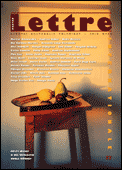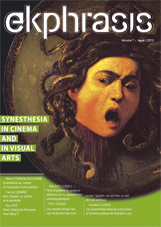
















Keywords: René Char; André Breton; Georges Duthuit; Wifredo Lam; Tristan Tzara; visual arts; surrealism; non-occidental art; non-hermeneutics
The word “synesthesia” was largely employed to designate the re-foundation of the relationship between music and painting, especially by the current of symbolism, in order to overcome “the lack of a common principle, available in the earlier paradigm through the notion of imitation”. In a broader perspective, it invites to re-think the function of art: is it intended only for sight or an experience of sensitive immersion attracting all senses? The title of the current study, taking up the title of Éluard’s book, Donner à voir, highlights this double meaning. I intend to consider it by a comparison between two texts of poets who praise the work of the painter Wifredo Lam: this comparison challenges the relationships of the subject and his surrounding world. I intend to demonstrate that the approach to painting by the French poet René Char, even when he pays tribute to the very painters celebrated by the surrealist André Breton, sets a different relationship with art. Against the visual fascination of Breton, against his denial of music, against his despise of the tangible aspect of painting, Char considers painting as a concrete art that encompasses other senses than the eye. Such an idea of the visual arts is to me one of the very characteristic of Char’s aesthetics and one of the important stakes of the dialog it follows with surrealist aesthetics. My study relies on contemporary art theories, notably those of Duthuit and of Tzara, which set in a wider context the optical primacy of the relationship to the visuals arts in France in the 20th century and which put it into the perspective of the art of non-occidental civilizations. I also call for the contribution of philosophers and historians such as Gumbrecht and Jolles.
More...
Keywords: kitsch; “the art of happiness”; Rainer Werner Fassbinder; painting; opera; melodrama; theatre; sculpture; alienation; violence
I establish my study on basically two theorists of Fassbinder’s aesthetics, the analysis of the kitsch in Fassbinder’s films by Françoise Dahringer and the articles on painting and music in his films by Vivien Villani. Then I take the idea of Abraham Moles, that Kitsch is “the art of happiness” and I use it to analyse a six minutes sequence in The bitter tears of Petra von Kant. Thereby, I show that Fassbinder’s film aesthetic is synesthetic. It is a superposition of kitsch objects, objects that provide happiness, which combine in a very unique way opera, painting, cinema and theatre. But in the case of Fassbinder, the kitsch does not provide happiness. My theory on kitsch as art of despair comes from Fassbinder’s theatre influences (Bertolt Brecht and Antonin Artaud). This film shows both the techniques of the theory of alienation and the “theatre of cruelty”. The first one adds a dimension of irony and the second adds the theatrical violence, which is exaggerated and spectacular. Both of these techniques create an alienation of the spectator. Whereby, the Kitsch becomes the art of despair.
More...
Keywords: haptic vision; cinema; cruelty; sensuality; Claire Denis; Trouble Every Day
This article about cruel haptic vision in the cinema will discuss film language, its text, even its texture, where tactility is difficult to transmit in a filmic text. Trouble Every Day (2001), as medium for these transmissions, addresses itself to the spectator’s senses, but contrary to what we can expect from an audiovisual medium, not to vision and hearing. In Trouble Every Day Claire Denis elaborates cinematic pictures which can make us feel, taste and touch the film. Initially, it was the philosopher Gilles Deleuze who formulated the concept of haptic vision with reference to the artist Francis Bacon and his painting of bodies. If Bacon’s paintings are haptic, they are more precisely cruelly haptic. But, as analysed later by Laura U. Marks, haptic vision is not a cruel process by nature. We speak about haptic vision when our vision reveals unsuspected connections with our other senses. With Denis, haptic vision is imbued with cruelty: we feel it in ourselves when forms become vague and objects and environment begin to merge.
More...
Keywords: contemporary theater; hologrammic theater; synesthetic staging; eroticism; skiagraphia; Claude Régy; Tarjei Vesaas; Salladhyn Khatir; Rémi Godfroy
Questioned about the theater play God’s Mist, Jean-Claude Ameisen, researcher in cellular biology, describes Claude Régy as “a synesthetic director”. The object of this paper will be to show that in God’s Mist, the last creation of the director Claude Régy, in collaboration with the scenographer Salladhyn Khatir and the creator of the lights Remi Godfroy, the spectator is synesthète as far as he is invited to resume with the faculty not to distinguish his various perceptions. He is also invited to take a posture in which he does not analyze any more where do his various perceptions come from. Consequently, it may happen that the spectator cannot differentiate the Touch or the Visual from the Sound. At first, we will show how Claude Régy stages the collusion of opposites by giving to hear a character who seems to speak without cancelling the silence. Secondly, we will analyze the synesthesia between the silence and the light. Indeed, the lights created by Remi Godfroy seem to skip into the silences of the actor, as if they answered him. In a conclusive part, we will study how the synesthesia creates hallucinations and, thus, how it reveals the body of the actor as a skiagraphia, in other words as a written shadow.
More...
Keywords: Philippe Grandrieux; Deleuze; cinema; five senses; haptic; return
Abstract: How can a director summon up the five senses of the audience through the film medium? How can a visual (and sound) art make affects tangible? An analysis of Sombre by Philip Grandrieux in the light of Deleuzian theories may help us to propound some answers to these questions. Thus, the underexposed film photography, the blurring effects and the strongly marked grain of the image are to be linked with the gaseous perception expounded by Deleuze. This perception, characteristic of experimental films, creates a suffocating feeling in the viewer, caused by the saturation of the senses. On the other hand, in Sombre, the representation of flesh and fragmented bodies is reminiscent of the works of Bacon and the notion of haptic: can an artwork be touched with the eyes? Is the appropriation of an image by the fact of “getting as close as possible to it” a way to fulfill the scopic drive? The exacerbation of the senses in Grandrieux also involves the desire to return to natural instinct, or even bestiality, which is transmitted from the diegesis (the main character) to the viewer. By means of a mise-en-scène and a film editing which play on the suggestive power of cinema, the filmmaker manages to transport the viewer, through a nomadic path, to a maelstrom of quasi-animal sensations.
More...